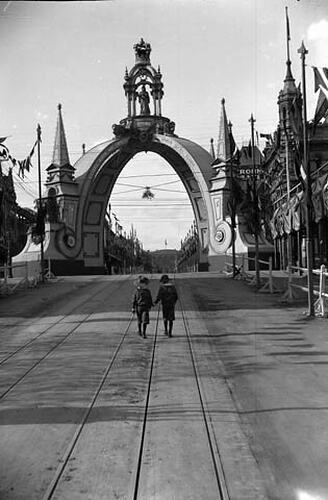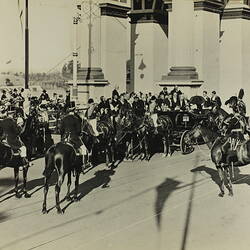Summary
Glass negative stereograph showing the Queen's Arch, built on the crest of the hill spanning the intersection of Collins and Russell street. It is part of the G. H. Myers Collection which consists of 73 photographs taken by Godfrey Henry Myers, an electrician and amateur photographer, in Melbourne during May 1901. 72 of these photographs depict preparations for the celebrations that surrounded Federation; all but one are glass stereographs. This collection represents Myers' one venture into commercial photography. It is significant for its images of the crowds, which do not feature so prominently in commercial photographs. The remaining photograph is a family portrait.
The opening of the Australian Parliament on May 9 1901 was an occasion for great celebrations in Melbourne. Ten days of festivities (from 6-16 May) were planned to mark the Federation of the new nation and honour the Royal visitors, the Duke and Duchess of Cornwall and York. The city was transformed with decorations - flags, bunting, colourful lights and festive arches - and a series of public events were held, including a military tattoo and several street parades. Unprecedented numbers of people arrived in Melbourne from the rest of Victoria and throughout Australia to take part in the celebrations.
Description of Content
Queen's Arch, Federation Celebrations, Melbourne, May 1901. The Queen's Arch (known colloquially as the 'cabmen's arch' for all the nearby parked cabmen) was one of the largest and most original of the Federation arches. Designed by George Austin, it was placed on the crest of the hill spanning the intersection of Collins and Russell street. The gilded statue by C. Douglas Anderson of Queen Victoria inside the gilded cupola at its apex was designed to catch the sun by day and to be lit like a beacon at night by lines of electric bulbs. The arch was painted in various shades of violet and outlined in white, silver and gold. Two young boys wearing sailor suit tops with knickerbocker pants are walking up the cable tram-lines towards the arch.
More Information
-
Collection Names
-
Collecting Areas
-
Acquisition Information
Donation from Mr Geoffrey Walker, 02 Jan 2001
-
Place & Date Depicted
Collins Street, Melbourne, Greater Melbourne, Victoria, Australia, 1901
-
Photographer
Godfrey H. Myers, Melbourne, Greater Melbourne, Victoria, Australia, 1901
-
Format
Glass Stereograph Negative, Black & White
-
Classification
-
Category
-
Discipline
-
Type of item
-
References
[Manuscript] Walker, Geoffrey. A City of Enchanted Palaces. The Federation Celebrations in Melbourne. May 1901. (unpublished).
-
Keywords
Australian Federation, 1901, Celebrations, Commemorative Arches, Royal Visits, Royalty


